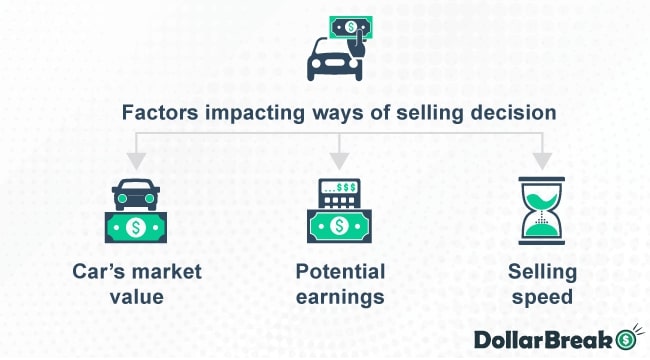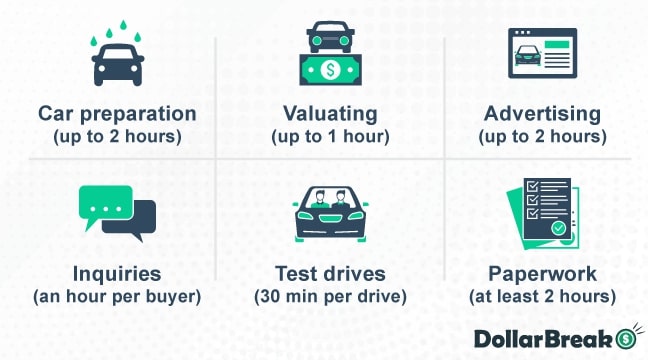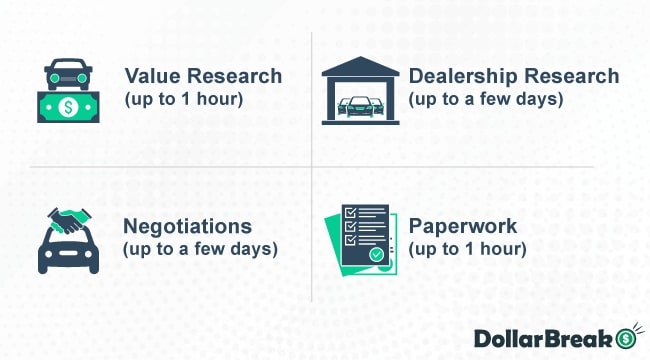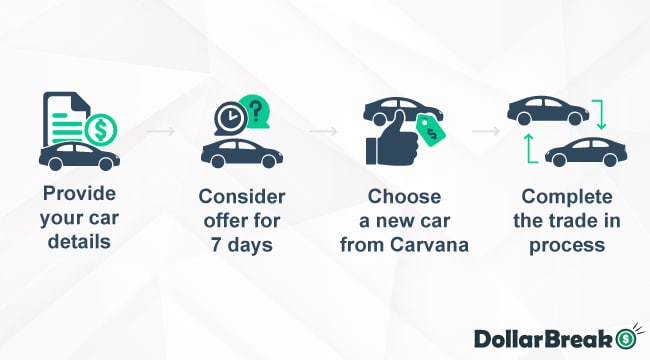Quick Answer:
If you’re short on time and need to sell and purchase a vehicle promptly, trading in is the more suitable option.
On the other hand, if you have the time and you want to maximize profit, selling your car independently is a better choice.
Personally, I favor selling my car first and then seeking a new one, as this approach allows me to select from a broader range of options without being restricted to a dealership’s inventory.
Key Takeaways:
- Trading In: Trading in your car is a quick and convenient choice, ideal for those wanting a new car immediately. It simplifies the process by applying the trade-in value towards the new purchase.
- Private Selling: Selling your car privately can yield a higher sale value, offering better financial returns despite requiring more time and effort in advertising and negotiation.
| Turnaroud | Effort Needed | Best For | |
|---|---|---|---|
| Privately | 52 days (on average) | Multiple steps | Used cars |
| Car Buying Website | 1-2 days | Fill online form | Old and junk cars |
| Dealership | 5-7 days | Visit office | Newer cars |
Best for Older & Damaged Cars

Buys used, damaged or junk cars
Free tow and no hidden fees
Pays by ACH trasfer or check
Top Pick for Junk Cars

Free, no-obligation cash offers
Offers free paperwork service
Pays on the spot upon pick up
Trading In vs. Selling Privately: How to Make a Decision?

When it comes to choosing the best way to sell a car, there are a few essential aspects to follow:
- Your car’s value and potential earnings
- The time needed to sell
Calculate Your Car’s Value and Potential Earnings
First, you need to determine the current market value of your vehicle. You can do this by browsing similar car listings and comparing them to your own vehicle on websites like eBay Motors or Autotrader. In addition to that, you should check Kelley Blue Book car’s valuation tool, which will give you estimates of both the private-party value and trade-in value of your car.
Once you have estimates for the trade-in value and private-party value of your car, you can calculate the difference between the two options.
Example: if you are selling a 2015 Honda Civic with 75,000 miles which has a trade-in value of $10,000 and a private-party value of $12,000, you would be able to get an additional $2,000 if you sold it privately.

How Fast Do You Need To Sell?
On average, it takes 52 days to sell a car to a private buyer. However, this is just an estimate, and it could take longer than this average; your car’s value can depreciate during this time, or there may be instances where the car does not sell at all.
In addition, you need to count the additional time you would spend making a sale.
It is estimated that it can take anywhere from 10 to 40 hours of your free time to sell a car privately. If your hourly wage is the national average of $33.44, then you would be spending an additional $1337.60 to sell a car.
How Much Time You Need to Sell Privately:
| Step | To do | Average time |
|---|---|---|
| Car preparation | Wash car & clean interior | Up to 2 hours |
| Valuating Your Vehicle | Find out market value | Up to 1 hour |
| Advertising | Take photos, upload listing | Up to 2 hours |
| Responding to Inquiries | Answer questions, negotiate | Up to an hour per interested buyer |
| Scheduling Test Drives | Arrange test drives | Up to 30 minutes per drive |
| Taking Care of the Paperwork | Finalize sell at DMV | At least 2 hours |

1. Car Preparation (up to 2 hours): despite your decision on how to sell a car, you should wash your car and clean the interior first.
On average, automatic car wash takes up to 5 minutes, but if you aim to wash it yourself, you will spend at least 30 minutes. Cleaning the interior (removing the trash, vacuuming the interior, wiping down surfaces, etc.) will take at least another 1 hour of your time.
This step is important because a clean car will add value, attract buyers and win their trust.
2. Valuating Your Vehicle (up to 1 hour): you should spend at least 1 hour researching the market value of your car. This process is crucial, as price impacts both the success of your selling and your financial benefit.
3. Advertising (up to 2 hours): prior to uploading your car listing online, you need to take good pictures from various angles, as well as showcase the interior. Pictures are a crucial thing to attract potential buyers and increase the chances of selling.
The next step is listing your car online. Write your car’s detailed description and list additional features. To reach a larger audience, it is advised to list cars on multiple websites.
4. Responding to Inquiries (up to an hour per interested buyer): the average time per potential buyer can vary depending on how interested they are in your car and how much negotiation is involved. It could take anywhere from a few minutes to an hour or more.
5. Scheduling Test Drives (up to 30 minutes per drive): on average, 84% of buyers test drive a vehicle before purchasing. The number of test drives you will need to arrange depends on multiple factors, but you can expect to spend at least 30 minutes per drive.
6. Taking Care of the Paperwork (at least 2 hours): if you have all the required paperwork, it can take a few hours to complete the documentation at DMV. But if you have lost your title, for example, you will need to apply for a duplicate title, which will take up to a few weeks to get. If your state requires a valid emissions test, you can spend another hour or so to get the certification.
How Much Time You Need To Trade In:
| Step | To do | Average time |
|---|---|---|
| Value Research | Find out the market value of your car | Up to 1 hour |
| Dealership Research | Find the best dealer | Up to few days |
| Negotiations | Negotiate the sale and purchase prices | 4 hours to few days |
| Paperwork | Gather and sign documents | Up to 1 hour |

1. Value Research (up to 1 hour): first of all, before accepting any offers, you should research the market. Using Kelley Blue Book car’s valuation tool, you will understand the estimated value of your car’s trade-in. Knowing the estimates gives you an edge in negotiations and helps you stand your ground. This way, you can avoid signing a financially unfavorable deal.
2. Dealership Research (up to a few days): each dealership you visit will provide you with a different offer. To choose the best offer, you need to visit as many dealerships as possible. Moreover, you should take a deeper look into each dealership’s offer: read reviews online to find out about customer experience and potential scamming and find out if there are any hidden fees.
3. Negotiations (4 hours to a few days): the length of negotiations with a dealership can vary depending on the complexity of the deal, the demand and availability of the car, and your negotiation skills. Negotiations can sometimes drag on for as long as several hours, which is actually a sales technique that works really well. Most car shoppers become so worn out from negotiations they agree to a terrible price just to get it over with. You should prepare to spend at least 4 hours at the dealership.
4. Paperwork (up to 1 hour): The dealership should take care of all the paperwork, but you will still need to spend some time gathering and signing documents. This includes signing the title over, filling out the bill of sale, submitting the release of liability, and canceling your insurance. All this process should take anywhere between 30 minutes to 1 hour.
Pros of Trading in a Car
Trading in a vehicle is a convenient option that allows you to transition from your old car to a new one in a single transaction. When you trade in a car, the dealership essentially buys your old car and deducts that amount from the cost of the new car you’re purchasing.
This can significantly reduce the overall price you pay for the new car, but it’s important to note that the trade-in doesn’t reduce the actual sticker price of the new car. It only allows you to pay less out-of-pocket or finance a smaller amount if you’re getting a loan.
- Convenience – trading a car is typically a more straightforward and more convenient process than selling a car privately. You can drive in with your old car and drive out with a new one on the same day.
- Efficiency – you don’t have to spend time advertising your car, meeting with potential buyers, arranging for test drives, or negotiating the price.
- Financial advantage – if you’re buying a new car from the same dealer, the trade-in amount can be put towards your new purchase, reducing the amount you’d need to finance. In some cases, dealerships also offer promotional financing deals if you’re trading in and buying a car from them.
- Saving on sales tax – In most states, you only pay sales tax on the difference between the trade-in value and the new car price, which can save you a lot of money.
Cons of Trading in a Car
Just as there are advantages to this method, there are also a few notable downsides that may affect your decision. Understanding these potential challenges can help you make a more informed decision about whether trading in is the right choice for you.
Cons of Trading in Your Car:
- Lower Sales Price – the trade-in value is more closely aligned with the wholesale auction value and is estimated to be 10-25% lower than that of the private sale.
- Negotiation difficulties – dealers are skilled at bargaining and maximizing their profit margin. If you do not have negotiating experience, you may find the process stressful and potentially end up accepting a less favorable offer.
- Limited options – You may have fewer choices when trading in your car, as you are limited to the dealerships that sell the brand and model of the new car you want or find dealers who will accept your car as a trade-in.
The average trade-in value is about 15% to 25% lower than the private sale value.
Pros of Selling a Car
Selling a car to a private buyer can be a financially beneficial decision. It is estimated that by selling cars privately, you can get up to 25% more compared to trading in.
- Higher Sale Value – you may get more money for your car than you could get from a dealer or an online platform. You can set your own price based on the market value and your car’s condition and features.
- Flexibility – you have more control over the selling process, such as choosing who to sell to, when to sell, and how to advertise. You can also avoid any pressure or influence from dealers or salespeople.
- Independent Decision-Making – unlike when trading in, there’s no pressure to buy a new car immediately or from a specific dealer.
Cons of Selling a Car
- Time-Consuming – selling your car yourself can take a lot of time and effort, as you have to prepare, advertise, and show your car, as well as handle the paperwork and payment. It may take weeks or months to find a buyer and complete the sale.
- More Effort – selling privately can also involve some expenses, such as cleaning, repairing, or advertising your car. You may also have to pay for a vehicle history report, a pre-purchase inspection, or a title transfer.
- Risk of No Sale – There’s no guarantee you’ll be able to sell the car, especially if it’s an older model or has high mileage.
- Security Concerns – you can expose yourself to some risks and scams, such as fraudulent checks, stolen cars, or personal safety threats. You may also face legal issues or liabilities if the buyer has a problem with the car after the sale.
- Payment Issues – the risk of payment issues, such as bounced checks or fraudulent payment methods.
- Transportation Gap – you may have to go without a car for some time until you buy a new one, which can be inconvenient and costly. You may have to rely on public transportation, ride-sharing, or car rental, which can add up to your expenses and limit your mobility.
- Loan Status – if you have an outstanding loan, it will be difficult to sell the car privately without paying off the debt.
Best Places to Trade in a Car
If you decide to trade in a car you can either visit your local dealerships in person or use trustworthy and nationwide companies like Carvana or Carmax.
1. Carvana

To trade in with Carvana you need to get an appraisal for your vehicle. This can be done by filling out an online form and entering details about the car’s condition and history.
Once you fill out the form your offer will be saved to your Carvana account for 7 days, giving you ample time to consider your options.
Additionally, you’ll be able to view the financial advantage of your trade-in as you explore the selection of vehicles on Carvana’s platform.
Depending on your location, Carvana can pick up your vehicle, or you can drive your trade-in to one of their locations.
2. CarMax
CarMax provides a fast and straightforward method for trading in your vehicle. You have the option to complete an online form to receive a cash offer digitally, or you can visit the nearest CarMax location to finalize the paperwork in person.
After receiving an offer from CarMax , it remains valid for a period of 7 days.
When trading in your car, you’ll need to present your identification, the Certificate of Title, and any additional documents mandated by your state.
How to Trade in a Car?
Trading in your car at a dealership can be a streamlined affair, but being well-prepared and knowledgeable about the procedure is crucial.
Here is a guide to navigating you through the process:
To successfully trade in your car, follow these steps:
- Research Your Car’s Value: Utilize tools from Edmunds, Kelley Blue Book, or NADAguides to estimate the trade-in value of your vehicle.
- Obtain Multiple Trade-in Offers: With your car’s estimated value in mind, seek out trade-in quotes from different dealerships and be open to negotiation to secure the best price.
- Prepare Your Car: Clean your car thoroughly and handle any minor repairs that could affect its trade-in value. Consider getting your car professionally detailed to improve its appeal.
- Organize Your Documents: When you decide to trade in your car, bring all necessary documents, such as the title, registration, proof of insurance, and any loan payoff details.
- Negotiate Trade-in and Purchase Prices Separately: To ensure you’re getting the best deal, negotiate the trade-in and new car purchase prices independently.
How To Sell a Car?
Selling a car involves a few key steps to ensure a smooth and successful transaction: gathering necessary documents, cleaning and making minor repairs to your vehicle, setting a fair price, and advertising the car through various platforms.
Each state has specific paperwork requirements for selling a car, so it’s important to check local regulations.
If you’re selling a car that’s still under finance, begin by getting in touch with your lender to find out the payoff amount, and let them know you plan to sell the vehicle.
Make sure potential buyers are aware there’s an outstanding loan. The buyer should pay the loan balance directly to the lender.
If your selling price is higher, the buyer will then pay the remaining balance to you.
How Do I Get a Fair Trade-in Value for My Car?
Before going to a dealership, find out your car’s market value by browsing online listings. You also should get appraisals from a few different dealerships to have leverage in negotiations.
Don’t just focus on the trade-in value, but consider the total deal instead. Moreover, do not be afraid to walk away if you are not satisfied with the offer.
What is the Fastest Way to Sell a Car?
The fastest way to sell a car is via online car-buying services like Peddle, CarBrain and Wheelzy. You will only spend 10 minutes getting the instant cash quote and accepting the offer. The rest of the process will be taken care of by Peddle’s associates. Your car will be picked up within 48 hours, and you will be paid on the spot.







